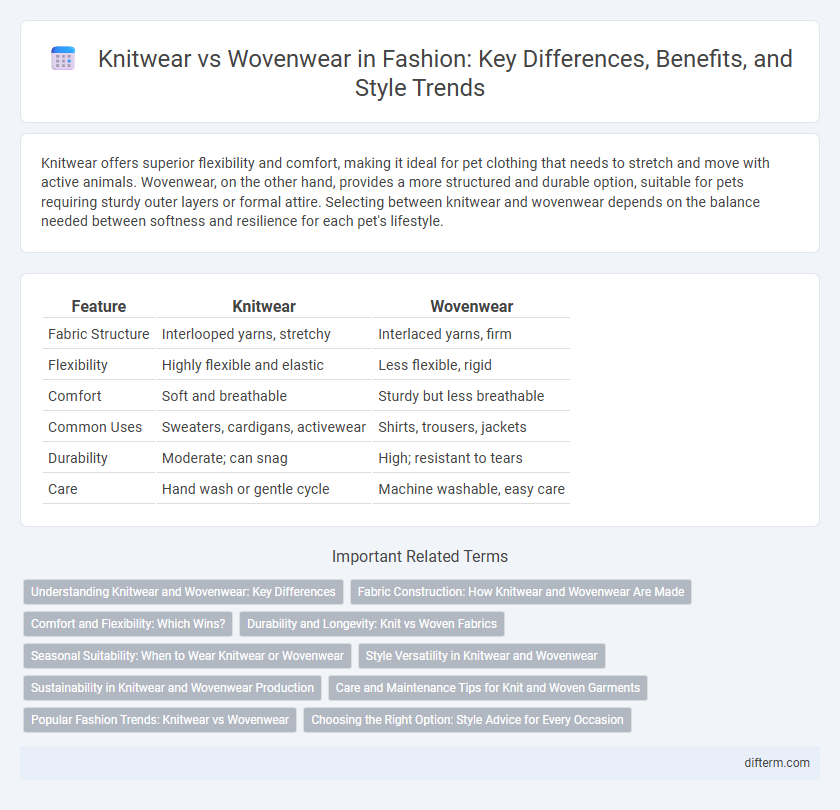Knitwear offers superior flexibility and comfort, making it ideal for pet clothing that needs to stretch and move with active animals. Wovenwear, on the other hand, provides a more structured and durable option, suitable for pets requiring sturdy outer layers or formal attire. Selecting between knitwear and wovenwear depends on the balance needed between softness and resilience for each pet's lifestyle.
Table of Comparison
| Feature | Knitwear | Wovenwear |
|---|---|---|
| Fabric Structure | Interlooped yarns, stretchy | Interlaced yarns, firm |
| Flexibility | Highly flexible and elastic | Less flexible, rigid |
| Comfort | Soft and breathable | Sturdy but less breathable |
| Common Uses | Sweaters, cardigans, activewear | Shirts, trousers, jackets |
| Durability | Moderate; can snag | High; resistant to tears |
| Care | Hand wash or gentle cycle | Machine washable, easy care |
Understanding Knitwear and Wovenwear: Key Differences
Knitwear is made from interlocking loops of yarn, offering stretchability and comfort, making it ideal for sweaters, cardigans, and casual wear. Wovenwear consists of yarns woven at right angles, providing durability, structure, and a crisp appearance, commonly used in shirts, trousers, and formal attire. Understanding the differences between knitwear and wovenwear helps in selecting the appropriate fabric for specific fashion needs based on texture, flexibility, and design purpose.
Fabric Construction: How Knitwear and Wovenwear Are Made
Knitwear is created through interlocking loops of yarn using knitting needles or machines, resulting in stretchable and flexible fabric ideal for garments like sweaters and cardigans. Wovenwear is produced by interlacing two sets of yarns at right angles on a loom, creating a firm and stable fabric commonly used for shirts, trousers, and jackets. The distinct fabric construction methods influence texture, durability, and elasticity, making knitwear suitable for comfort-focused designs and wovenwear preferred for structured silhouettes.
Comfort and Flexibility: Which Wins?
Knitwear stands out for superior comfort and flexibility due to its looped yarn construction, allowing greater stretch and breathability compared to wovenwear's interlaced threads, which offer less give and rigidity. The elasticity of knit fabrics adapts better to body movements, making it ideal for casual and activewear, while woven fabrics tend to maintain shape and provide structured fits. For optimal comfort and ease of movement, knitwear is the preferred choice in contemporary fashion.
Durability and Longevity: Knit vs Woven Fabrics
Knitwear generally offers superior elasticity and resistance to stretching, which enhances its durability by preventing fiber breakage under tension. Woven fabrics, known for their tight interlaced structure, provide exceptional strength and longevity, maintaining shape and resisting wear over time. The choice between knit and woven fabric durability depends on the specific use case, with knits excelling in flexibility and wovens in structural integrity.
Seasonal Suitability: When to Wear Knitwear or Wovenwear
Knitwear excels in cooler seasons like fall and winter due to its insulating properties and flexibility, providing warmth and comfort. Wovenwear is ideal for spring and summer as it typically offers a lighter, more breathable fabric structure that helps regulate body temperature. Choosing between knitwear and wovenwear depends on seasonal temperature variations and the desired level of breathability and comfort.
Style Versatility in Knitwear and Wovenwear
Knitwear offers superior style versatility, adapting effortlessly from casual to sophisticated looks due to its flexible, stretchable fabric that contours to the body and allows for layering. Wovenwear, with its structured and crisp appearance, provides a polished and tailored aesthetic ideal for formal or professional settings but often lacks the ease of movement found in knitwear. Combining both knitwear and wovenwear pieces can create dynamic outfits that balance comfort with refined style.
Sustainability in Knitwear and Wovenwear Production
Knitwear production typically consumes less water and generates less fabric waste compared to wovenwear, making it a more sustainable choice for eco-conscious fashion. The circular knitting process allows for seamless garments, reducing material offcuts and improving resource efficiency. Wovenwear often requires more energy-intensive processes and chemical treatments, increasing its environmental footprint relative to knitwear alternatives.
Care and Maintenance Tips for Knit and Woven Garments
Knitwear requires gentle washing in cold water and flat drying to prevent stretching and distortion, while woven garments benefit from machine washing on a gentle cycle and tumble drying on low heat to maintain their shape and texture. Avoid using harsh detergents on both fabrics to preserve fiber integrity, and always store knitwear folded to avoid snagging, whereas woven items can be hung to reduce wrinkles. Regularly inspect seams for wear in wovenwear and watch for pilling in knitwear to extend the lifespan of each garment.
Popular Fashion Trends: Knitwear vs Wovenwear
Knitwear has surged in popularity due to its comfort, flexibility, and ability to offer intricate textures that resonate with modern casual and athleisure trends. Wovenwear remains favored for structured, tailored looks, often seen in formal and business fashion, emphasizing durability and crisp silhouettes. Current trends blend knitwear's softness with wovenwear's precision, creating hybrid pieces that appeal to versatility and style innovation in contemporary wardrobes.
Choosing the Right Option: Style Advice for Every Occasion
Knitwear offers unparalleled comfort and flexibility, making it ideal for casual outings and layering in cooler weather, while wovenwear provides a structured silhouette perfect for formal events and professional settings. Selecting knitwear with textured patterns can elevate a relaxed look, whereas opting for tailored woven pieces enhances sophistication and sharpness. Balancing both options in your wardrobe ensures versatility, catering to diverse occasions from cozy weekends to elegant evenings.
Knitwear vs wovenwear Infographic

 difterm.com
difterm.com